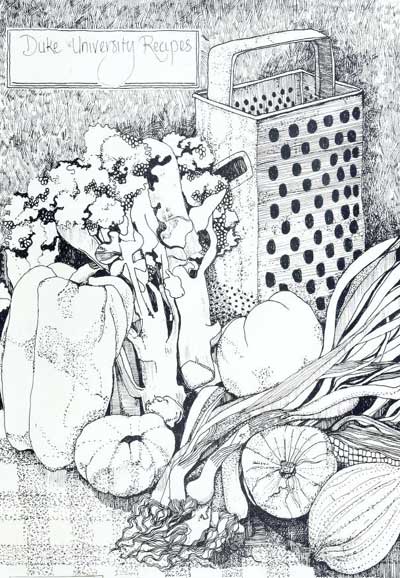 If there is one truism about librarians it is that as a general rule, librarians are excellent cooks and bakers and they love to share their food. On the flip side, I’ve never seen food go to waste in a library. Your experimental cookie recipe didn’t turn out quite as you expected? Take them to work, someone will eat them.
If there is one truism about librarians it is that as a general rule, librarians are excellent cooks and bakers and they love to share their food. On the flip side, I’ve never seen food go to waste in a library. Your experimental cookie recipe didn’t turn out quite as you expected? Take them to work, someone will eat them.
This month, Amy McDonald and Beth Doyle of the Rubenstein Test Kitchen turn their attention inward to focus on our very own food culture. The recipes this month came from Duke University Recipes: A Collection of Recipes from the Duke University Community, Compiled by the Duke University Library Staff Association (DULSA). This cookbook, dated 1977, was one in a series of annual cookbooks compiled by DULSA.
Our first impression of the recipes in Duke University Recipes is that they are reminiscent of a particular type of independently-produced cookbooks (e.g. those created by churches, social clubs, member groups, etc.). If you are a fan of this genre of cookbooks you will recognize many of these recipes if not verbatim then by familiarity. They seem to be firmly situated in the culinary traditions of the 1970’s. The recipes often mix prepared food stuffs (so much Jell-O) with fresh (or “fresh”) foods to create something not quite from-scratch but better than from a box alone.
While there are many worthy entries in this cookbook, we wanted to pay homage to our colleagues by choosing three recipes submitted by Duke Libraries staff members who are still working at the library.
Orange Jello Cake (Recipe by Robert Byrd; baked by Beth)
This recipe is one of those that is still popular today. It is usually called a “no bake cheesecake” or some variation of that theme. The recipe consists of a graham cracker crust, a cream cheese and whipped topping layer, and a Jell-O layer with canned fruit and orange sherbet added to the gelatin. When I asked Bob Byrd about this recipe he said, “I have only a vague memory of this recipe, and I disclaim all responsibility for it.”
The first two layers came together fine. The Jell-O layer was weird. It had so much liquid added to the Jell-O that it never really solidified, which was fine until it was served up. When cut and plated, the orange layer just slid off the base. But, as one taster said, “It all mixes in your stomach anyway.” True enough.

Taste-wise, it wasn’t half bad. The squishy Jell-O layer played nicely with the cream cheese layer. The graham cracker crust provided a textural contrast to the soft upper layers. In terms of preparation, I think if you omitted the sherbet the Jell-O would set properly and not be so messy to eat.
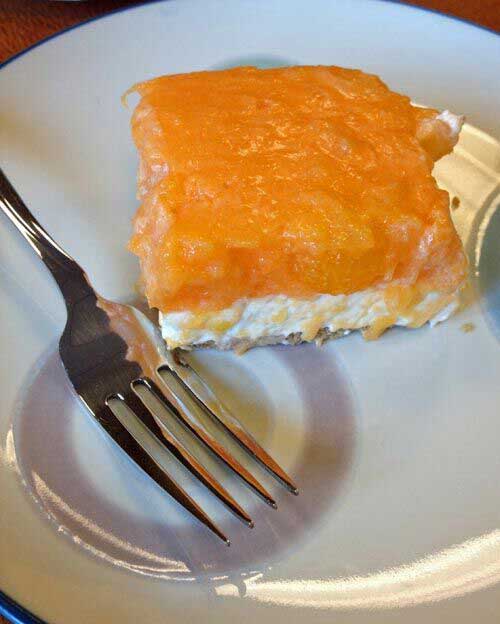 And, as a final note, one of our colleagues (who was born way after the 1970s) commented, “This tastes exactly like what I imagine the 1970s to have been like.” So there you go.
And, as a final note, one of our colleagues (who was born way after the 1970s) commented, “This tastes exactly like what I imagine the 1970s to have been like.” So there you go.
DULSA Punch (Recipe by Cathy Leonardi; poured by Amy and Beth)
 We were surprised at how many recipes in this book called for bourbon. We were pleasantly surprised we found one we wanted to try. According to Cathy Leonardi, “DULSA only served alcohol at one party each year, the Christmas party. The DULSA punch was the punch that was served. Wink was like 7-Up. The beauty of the punch was that it was easy to make. I didn’t invent the recipe. It was given to me by someone who had previously made it for the Christmas party. I put the recipe in the cookbook so that it would be easy to find for future parties.” And are we glad she did!
We were surprised at how many recipes in this book called for bourbon. We were pleasantly surprised we found one we wanted to try. According to Cathy Leonardi, “DULSA only served alcohol at one party each year, the Christmas party. The DULSA punch was the punch that was served. Wink was like 7-Up. The beauty of the punch was that it was easy to make. I didn’t invent the recipe. It was given to me by someone who had previously made it for the Christmas party. I put the recipe in the cookbook so that it would be easy to find for future parties.” And are we glad she did!
As far as punch recipes go, this is an easy one. The hardest part was finding the Wink soda (or is that pop?). Yes, Wink is still available but it is often found in the mixers section, not with the other sodas.
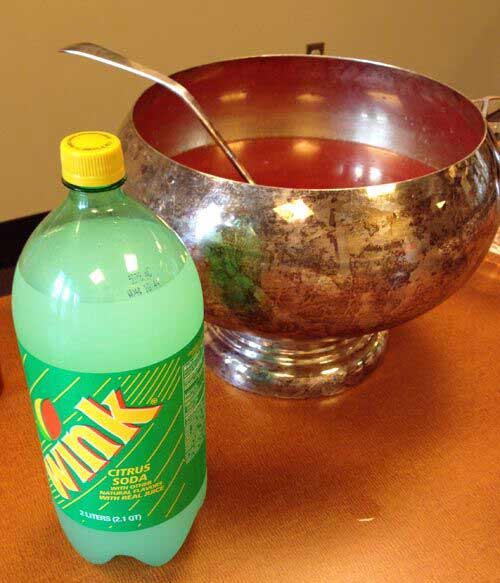 It mixes up to a beautiful reddish color. This is a very sweet punch with a little hint of Southern Comfort. Admittedly, we purchased the lower alcohol Southern Comfort since we planned on serving this at a reception at work. (We made a non-alcoholic version, too, but . . . that was less popular.) The general consensus was that it was the best thing on the table when we taste tested the recipes.
It mixes up to a beautiful reddish color. This is a very sweet punch with a little hint of Southern Comfort. Admittedly, we purchased the lower alcohol Southern Comfort since we planned on serving this at a reception at work. (We made a non-alcoholic version, too, but . . . that was less popular.) The general consensus was that it was the best thing on the table when we taste tested the recipes.
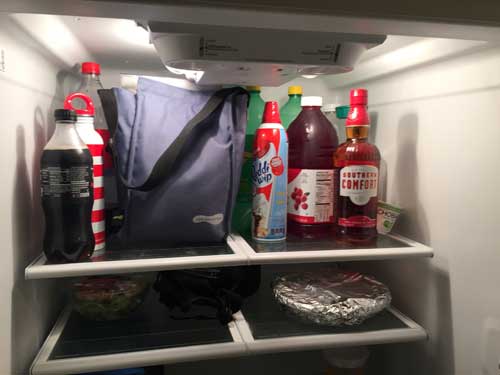
Strawberry Pie (Recipe by Vickie Long; baked by Amy)
 This is a pretty simple recipe. I started out with tons of strawberries and a store-bought crust (yesssss!). Half of the strawberries got sliced and dumped (or arranged prettily, if you prefer) into the baked crust, and the other half got mashed and cooked with the cornstarch and baking powder into what I like to fondly call the “strawberry goop.”
This is a pretty simple recipe. I started out with tons of strawberries and a store-bought crust (yesssss!). Half of the strawberries got sliced and dumped (or arranged prettily, if you prefer) into the baked crust, and the other half got mashed and cooked with the cornstarch and baking powder into what I like to fondly call the “strawberry goop.”
I have a tremendous fear of burning things, so I may not have let the strawberry goop cook—and thus thicken—quite as long as I should have. I poured it into the pie, let the whole thing set in the refrigerator, and the result was a sort of sweetened strawberry soup, with bits of crust. Not terrible, but maybe not what you want to serve at your next dinner party. Or maybe it is? You do you, you know?
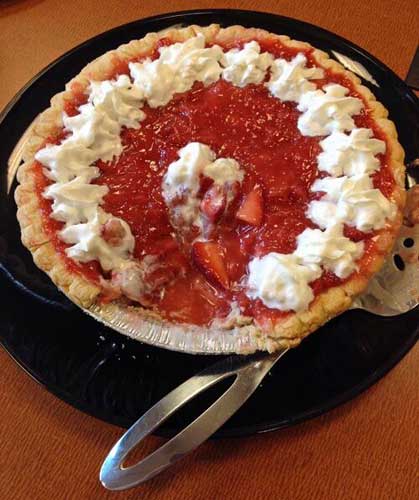
As a saving grace, I was going to make real whipped cream, but Beth thought Reddi-wip would be more authentic. And archivists are nothing if not historically authentic.
 Duke University Recipes is available through the Duke University Archives, as well as online at the Internet Archives. There is also a copy of this 1977 edition in the Perkins Library that you can check out.
Duke University Recipes is available through the Duke University Archives, as well as online at the Internet Archives. There is also a copy of this 1977 edition in the Perkins Library that you can check out.
Let us know in the comments if you try any of the recipes!
Post contributed by Beth Doyle, Leona B. Carpenter Senior Conservator and Head, Conservation Services Department, and Amy McDonald, Assistant University Archivist.





We LIVED the 1970s and do not care to return–on so many levels and in so many areas, food being a major one. I understand the lure of history (even beyond marrying, loving, and living with an historian for 52 years at this point), but actually “eating it”? No thanks. You were very brave to do this experiment, but today food is SO much better. Keep it fresh, keep it meatless, and keep it organic.